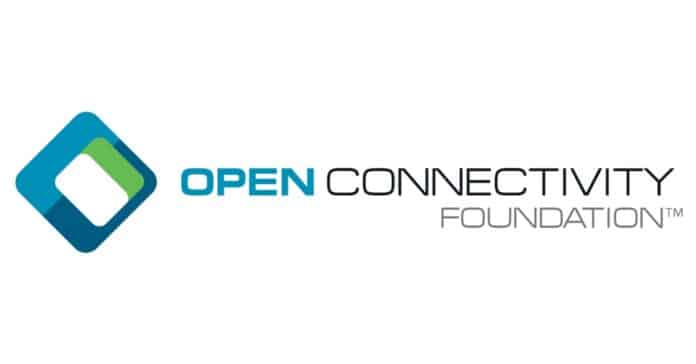
Open Connectivity Foundation (OCF) defines a Secure IP Device Connectivity Framework that connects and intelligently manages the flow of information among devices to address the emerging needs of the Internet of Things. OCF is agnostic to form factor, operating system, vertical market, manufacturer, or service provider. It also promotes the goal of broad interoperability via collaboration with other organisations and standards. Open Interconnect (OIC) was formed by industry leaders in 2014. Later OIC was unified with AllJoyn and evolved as Open Connectivity Foundation (OCF).
OCF 1.0 specifications were ratified and accepted as international standards by ISO/IEC in 2018. Further, OCF specifications kept on evolving to support many consumer-centric use cases, robust security and interoperability. OCF 2.2.3 specifications can be downloaded from openconnectivity.org. It has an exclusive working group for the smart home. Smart Home Working Group identifies requirements for smart homes and creates profiles, specification contributions and aligned data models that support identified smart home requirements.

When asked about the importance of having a secure & interoperable IoT to develop better-connected solutions for Smart Homes & Intelligent Buildings, Dr Aloknath De, CTO, Samsung Research India and Chair, OCF India Forum, says, “Security and Interoperability are two key aspects of IoT. Even in legacy digital communication such as browsing and streaming, security has been crucial. In the case of IoT, all your devices at home or building are connected and can be accessed from anywhere. Hence the need and robustness of end2end security over the wire are more than ever before. OCF provides robust end2end security over the wire. OCF specification maps to 5 influential IoT baselines, namely NIST, CTA, ENISA, ETSI, UKs code of practice for consumer IoT security”. “Open interoperable standards help all the players, small or big, to complement each other and build a strong ecosystem which eventually benefits the biz and consumer. It’s a clear win-win situation. For instance, OCF is agnostic to underlying connectivity be it Wi-Fi or Thread and maps its data model with other popular protocols such as OneM2M, EnOcean, UPlus, AllJoyn, ZigBee, ZWave, BLE”, he adds.
What is the difference between a smart, automated, and a connected home?
A connected home is one where each device is paired with an application. For instance, your smartphone has an application to control light and another application to control the thermostat. A smart home is one where multiple devices are connected to a common service and share information among them. Typically, devices in a smart home can be controlled using a single application in your smartphone. In a sense, you may call a smart home a “Fully Connected Home”. In a smart home, if device actions are automated when certain conditions are fulfilled, you can call it an automated home.
What future trends do you foresee in the Smart home space in the short-to-medium term time frame?
In the past few years, major appliance companies made smart devices available to the consumer. Currently, In terms of user experience, we see a small limitation in the current smart home ecosystem. Smart appliances of different manufacturers can’t be paired with each other which hampers device-to-device communication and automation among the devices from different manufacturers. OCF has a solution to address this problem. OCF Universal Cloud Interface (UCI) enables devices connected to different clouds to communicate seamlessly.
In the short term, we see smart TVs and appliances would be controlled by smart applications through mobile phones. Also, we see intelligent communication and automation among relevant devices to save power or to deliver a unique consumer experience. For instance, the air conditioner would turn off automatically when Thermostat is turned on or the living room’s ambient lighting would be adjusted when the TV is turned on. In the long term, we see all devices in a smart home working in tandem. For instance, the security camera recognizes your car is approaching and tells the thermostat to change the house temperature, turn on all necessary lights and preheat the oven. Also, we see smart homes seamlessly connected to the smart city for mutual service utilization.
What market opportunity do you see in India?
In the 2nd Smart Home Expo, Bangalore, I elaborated on Indian market opportunities in my inaugural keynote talk on “Smart Homes in India: Making them a Reality”. Smart home revenue in India is expected to show an annual growth rate (CAGR) of more than 20% over the next 5 years. In India entertainment, home surveillance, low-cost smart devices, energy-efficient smart homes would catch momentum. A consumer would start the IoT experience with smart TVs, security cameras, air conditioners, smart plugs, switches, and lights. Being a matured specification for smart homes and buildings and the end2end technical offerings it has for SMEs, OCF is comfortably positioned as the first choice for deploying smart homes in India.
What are OCF’s technology offerings? What role OCF is playing in helping manufacturers to produce customer-centric smart home devices?
OCF provides a specification, open-source, and certification program to enable manufacturers to bring OCF certified products to the market. OCF provides two reference device solutions namely, IoTivity for resourceful devices and IoTivity-Lite for constrained devices with Apache 2.0 license along with free tools for compliance verification. OCF also provides a reference cloud solution (plgd.dev) so that manufacturers can deploy it on any cloud platform of choice. OCF defined more than 100 types of devices (home and kitchen appliances, space conditioning, lighting, multimedia, personal health and so on) and the behaviours associated with each type of device. This would enable manufacturers to produce an extensive range of customer-centric products for smart homes and buildings.
What are OCF’s objectives & membership benefits?
The primary objective of OCF is to have an Open IoT Ecosystem, wherein interoperability, security, scalability, and consumer focus are the key building blocks. OCF has various membership levels tailored for the research and business needs of organizations. Adopter members can use the standard, Gold (and non-profit educational gold) members can create the standard, Platinum members can create and vote on the standard, and Diamond members can influence the organization by taking chair positions in various workgroups.
What role OCF India Forum is playing in the country?
The main objective of the OCF India Forum is to bring more OCF devices to the Indian market by creating OCF awareness in India and helping SMEs to build products with OCF. To achieve this, we reach out to SMEs through various developer events, workshops and published blogs/podcasts/articles. Additionally, OCF India Forum collaborates with Indian SDOs, Trade and Government bodies such as TSDSI, NASSCOM to build OCF-based interoperable & secured IoT ecosystem in India. Currently, we are collaborating with TSDSI to prototype and demonstrate Smart Home- Smart City cases using OCF bridges.
Contact – Email: [email protected]















